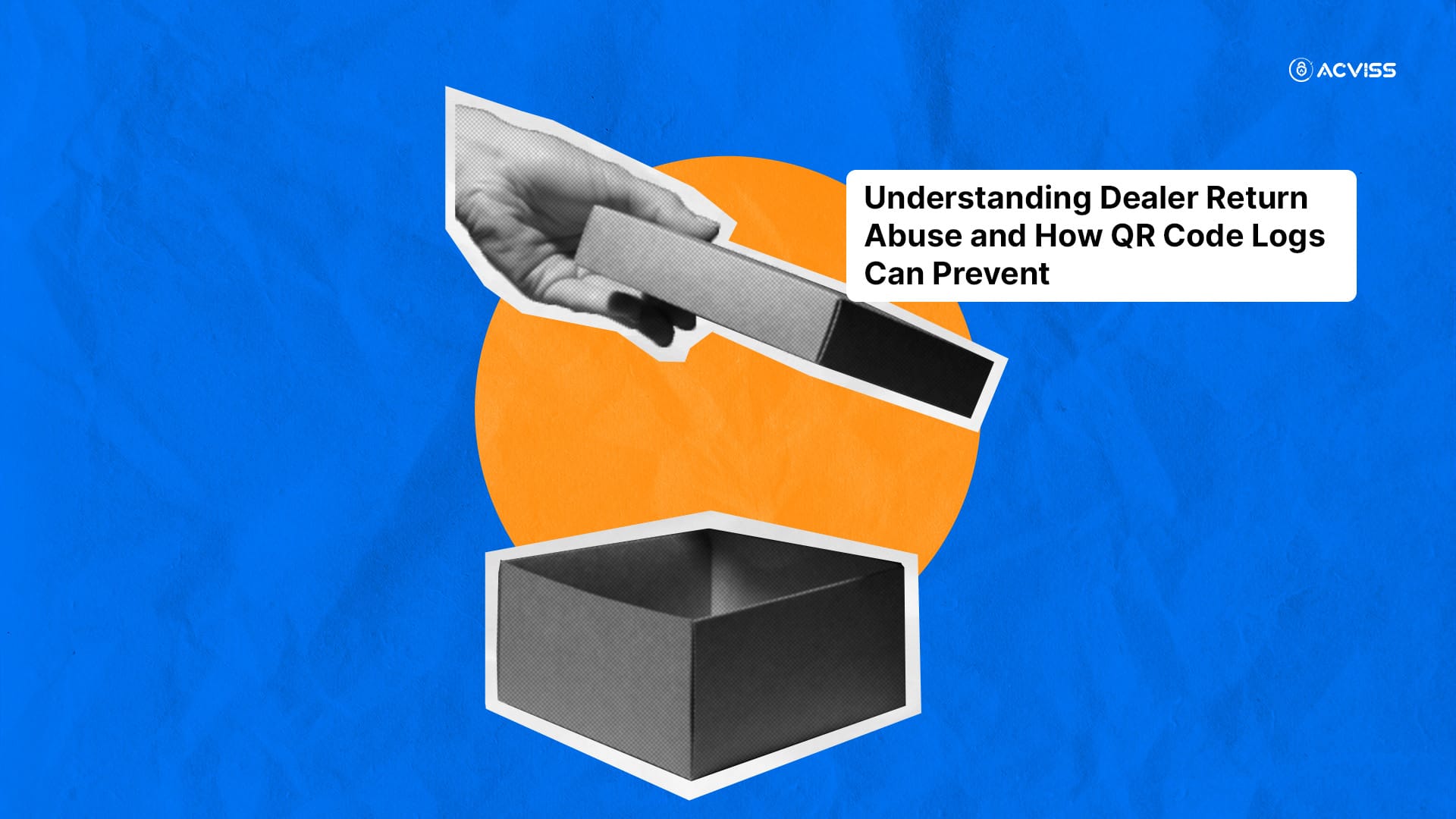Understanding Dealer Return Abuse and How QR Code Logs Can Prevent It

Dealer return abuse is a growing challenge not just in the paint industry, but also in sectors like agro-chemicals and automotive spare parts. While some product returns are valid, abuse happens when dealers misuse the return process by manipulating expiry dates, fabricating unsold inventory claims, or rerouting goods outside the authorised supply chain (pilferage). These practices quietly erode margins, disturb inventory planning, and expose brands to counterfeit risks and regulatory scrutiny.
Dealer return abuse is one of the least visible yet most damaging issues facing manufacturing brands today. While legitimate returns are part of business, abuse happens when dealers falsely claim unsold stock, manipulate expiry narratives, or redirect inventory through backdoor channels. These actions cost brands in refunds, trust, and supply chain balance.
What Does Dealer Return Abuse Look Like?

Dealer return abuse does not follow a single pattern; rather, it manifests in multiple subtle forms that can vary across industries. Some of the most common include:
False Unsold Claims: Dealers claim products remain unsold or damaged when they were, in fact, sold through informal channels.
Expiry Manipulation: Units approaching expiry are stockpiled and returned in bulk to force credit or replacements.
Geographic Mismatch: Returns are initiated from regions where the brand’s official supply chain has not supplied goods.
Duplicate or Suspicious Scans: The same QR code is scanned multiple times across different locations, suggesting rerouting or counterfeiting.
For instance, in the agro-chemical industry, a distributor may claim that large stocks of pesticides remain unsold due to market conditions, while in reality, those products have already been rerouted to unauthorised markets at discounted rates. Similarly, in the automotive spare parts sector, fake claims about returns often conceal pilferage or counterfeit substitution.
These activities not only impact revenue but also risk regulatory violations, especially in sectors with strict compliance requirements such as pharmaceuticals or chemicals.
Why Traditional Monitoring Falls Short
Most manufacturers rely on Enterprise Resource Planning (ERP) systems, batch logs, or manual checks to monitor dealer activities. While these tools provide a broad view of inventory flow, they are not equipped to catch abuse at the unit level.
The limitations are clear:
Editable Logs: ERP records and stock sheets can be falsified or manipulated.
Batch-Level Blind Spots: Tracking at the batch level fails to reveal the movement of individual units, making it difficult to trace irregularities.
No Real-Time Audit Trail: Without unit-level scan data, it becomes nearly impossible to validate whether a returned product followed the authorised route.
This lack of visibility creates fertile ground for abuse. A dealer can reroute or stockpile goods, file for credit, and still appear compliant on paper. By the time discrepancies surface, losses have already been absorbed.
QR Code Logging: A Smarter Solution
The rise of digital authentication and traceability systems offers manufacturers a powerful tool against dealer return abuse. QR-based logging systems, when implemented correctly, introduce transparency at the unit level rather than relying solely on batch records.
Solutions like Acviss Origin, combined with non-cloneable QR codes, enable brands to capture granular, real-time data about every product unit’s journey. This creates an unbroken digital audit trail that is difficult to manipulate.
Here’s how it works:
1. Unit-Level Tracking
Every unit receives a unique, tamper-evident QR code (enabled through technologies such as non-cloneable labels). This provides:
A secure, verifiable identity for each product.
- Proof of origin and legitimacy, ensuring the product cannot be cloned or duplicated.
2. Real-Time Scan Logs
When products are scanned at different points, whether by distributors, dealers, or consumers, the following information is logged:
- Time and date of scan.
- Location of scan.
- Device ID and user information.
- This granular data allows brands to see who scanned what, where, and when.
3. Anomaly Detection with Dashboards
Here’s where Origin plays a key role. The system’s dashboard aggregates scan data and flags suspicious activity, such as:
Returns initiated from unauthorised zones.
Duplicate scans on the same unit.
Bulk returns after long inactivity, suggesting stockpiling.
- With this intelligence, manufacturers can proactively investigate and address fraudulent patterns before they escalate.
Real Benefits Across Industries

Real Benefits Across Industries
QR code logging systems do more than just catch fraud; they transform how manufacturers manage their supply chain. Some of the tangible benefits include:
Prevention of Fraudulent Returns: Detect and stop false claims before they result in unnecessary refunds or credits.
Improved Transparency: Gain visibility across dealers and distributors, reducing blind spots.
Accountability in Relationships: Genuine partners appreciate the transparency, while fraudulent ones are deterred.
Operational Efficiency: Stronger data integrity improves forecasting and inventory planning.
For example, in the paint industry, QR logs can help identify if a large batch of paint is being returned from a region where it was never officially distributed. In the automotive space, duplicate scans of spare parts highlight the possibility of counterfeit substitution or rerouting.
A Practical Example
Consider this scenario in the agro-chemical sector:
A manufacturer ships 500 bottles of pesticides to a dealer in Karnataka.
A month later, 250 bottles are returned, but the paperwork shows the return originated in Punjab.
With QR scan logs, the manufacturer discovers:
None of the returned units were ever scanned in Karnataka.
Multiple scans occurred in warehouses outside the official dealer network.
The Origin dashboard triggered a fraud alert based on these anomalies.
This level of insight would be impossible with traditional ERP systems alone. By implementing QR logging, the brand not only prevents financial loss but also strengthens compliance in a sector where regulatory oversight is increasing.
How Manufacturers Can Implement This
Integrating QR code logging into existing operations is not as complex as it may seem. The process generally involves three steps:
Apply Non-Cloneable Labels: Secure labels are affixed to every product unit during manufacturing.
Activate Scanning Points: Scanning is enabled at warehouses, distributor points, and dealer outlets to capture real-time data.
Monitor and Act: Data flows into dashboards like Origin, where geo and time filters help identify unusual patterns.
The transition requires minimal disruption to existing processes but creates a significant leap in accountability and visibility.
Conclusion
Dealer return abuse is often a silent drain on profitability, operating behind the scenes of legitimate supply chain activity. Left unchecked, it not only erodes margins but also destabilises operations, damages trust with genuine partners, and exposes brands to counterfeit risks and regulatory penalties.
Solutions like Acviss Origin provide exactly this capability, empowering brands to track products at the unit level, detect anomalies in real time, and prevent fraudulent returns before they harm the business.
Let’s explore how Acviss Origin can help your brand. Book a demo, and we’ll walk you through it together.
